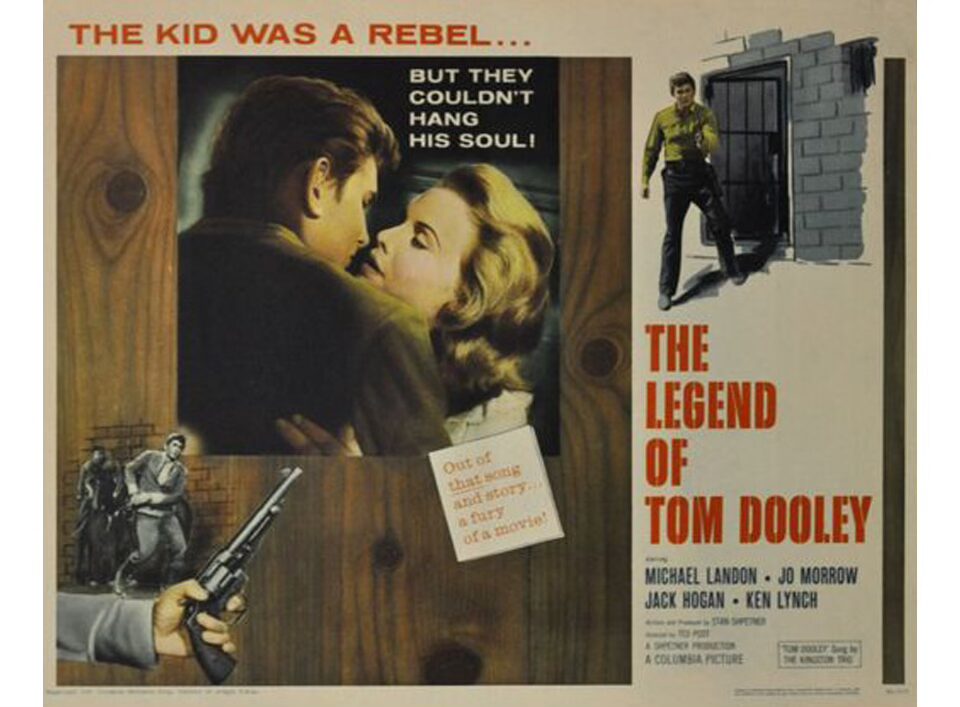In 1866, a woman named Laura Foster was murdered in Wilkes County. A man named Tom Dula, pronounced “Dooley”, was convicted and hanged for the crime. That murder and the name Tom Dooley live on in one of the most famous folk songs ever to come out of North Carolina.
The traditional version of the story casts Tom Dula as a dashing, handsome Confederate veteran. When Dula returns from the war, he meets Laura Foster, a young woman who was being courted by a schoolteacher from the North by the name of Bob Grayson. Foster fell in love with Tom Dula, but so did another woman, Anne Melton. Melton was married, wealthy, beautiful, and insanely jealous. Learning that Dula was in love with Foster, not her, Anne Melton stabbed Laura Foster to death in a jealous rage.
Tom Dula was blamed for the murder. Dula fled, heading for Tennessee. Bob Grayson headed a posse to hunt down Tom Dula, and the posse dragged the fugitive back to Wilkes County. Dula realized that it was Anne Melton who had committed the crime. Tom Dula’s sense of chivalry made him unwilling to see a wealthy woman dishonored and facing a death by hanging. So Dula confessed to a murder he did not commit in order to save Melton’s reputation.
On May 1, 1868, Tom Dula was executed for the murder of Laura Foster. Grayson returned home to the North. Anne Melton went slowly insane from guilt, and years later as she was on her deathbed, the trees around her house filled with back cats and the air was filled with the smell of burning flesh as demons came to take her soul to Hell.
It’s this version of the tale, a complicated story story that ends in the death of an innocent man, that became immortalized in a folk song that circulated in North Carolina for nearly 100 years before it was made nationally famous by the Kingston Trio in 1958. In a way which shows how much the ways in which we define music categories has changes in the past half-century, The Kingston Trio recording of the Ballad of Tom Dooley reached #1 on the Billboard R&B charts, even higher than its near-top placement on Billboard’s Country charts.
It’s said that Tom Dooley wrote this song himself. The legged has it that he that he was signing it, strumming along on his banjo, as he sat on top of his own coffin riding in the wagon on the way to his execution.
But the actual history behind the story of Tom Dula and the murder of Laura Foster are what might be generously described as slightly different from how he song tells it.
More About This Story
The real story of Tom Dooley and Laura Foster is a lot more complicated than the version told in the song. And it involves a lot more syphilis.
Tom Dula was born in the deeply impoverished mountains surrounding the Yadkin Valley in 1845. Sometime when he was a fairly young teenager, he began sharing the household of James Melton and his wife Anne. Melton was a successful cobbler, and had lost interest in his much younger wife, who happened to be about the same age as Dula. With James Melton’s consent, Tom Dula and Anne Melton began sharing a bed in Melton’s cabin. James Melton slept alone.
Dula left the Melton household temporarily when he volunteered for the 42nd Regiment of the North Carolina Infantry. After the war, he returned to the hills and resumed his unusual household arrangements. But then things began to get even more romantically complicated.
Pauline Foster, a distant cousin of Anne Melton, had moved in to the Melton household when she was hired as a servant. It must have been a small cabin, because soon, Dula and Pauline Foster began having an affair. In a remarkable display of open-mindedness, Anne Melton didn’t object to her lover’s new arrangement. In fact, she joined in. So Anne Melton, Pauline Foster, and Tom Dula were all sharing a bed in James Melton’s cabin. James Melton was still sleeping alone.
As if this wasn’t complicated enough, Tom Dula soon met another Foster. This was Laura Foster, another cousin of Anne Melton, who had recently followed her cousin to the area. Laura Foaster was no stranger to the company of men, and soon she and Tom Dula were carrying on together, in an affair seemingly completely separate from Dula’s arrangements back in Melton’s cabin. Splitting his time between Laura Foster and his menage à trois in the Melton household seemed to keep Dula happy and probably pretty tired.

What Dula didn’t know was that Pauline Foster hadn’t come to the area just to seek employment, she also came seeking treatment for syphilis. As is the way with such things, Pauline gave the disease to Tom, who then gave it to Laura and to Anne. But because of the timing of the appearance of symptoms, Tom Dula thought that it was Laura Foster, and not Pauilne Foster, who had infected him. Dula vowed revenge on Laura Foster.
Laura Foster disappeared on May 25, 1866. That morning, Foster’s father woke to discover both her and his horse missing. The horse returned the next day, but Laura did not. After several weeks of searching, a rope that had been used to tie Foster’s horse to a tree was discovered on bloodstained ground not far from where Tom Dula was living. Suspicion immediately began to fall on Dula, and he fled for Tennessee.
About the same time, Pauline Foster also visited Tennessee, and when she returned to Wilkes county a friend jokingly inquired if she had left because she had killed Laura Foster. Pauline Foster, also seemingly in jest, replied that she and Tom Dula had killed Laura together. Pauline Foster was soon arrested and charged as an accessory to murder.
Fearing for her life, Pauline Foster told everything she knew. Dula and Anne Melton had killed Laura Foster together. She led them to the Laura Foster’s shallow grave in the woods, and her badly-decomposed corpse was exhumed. The body was only identifiable from the clothing, but the evidence of a vicious stab wound under the left breast into the heart was still there.
The police learned that Tom Dula was living in Tennessee, where he’d been working on the farm of a Colonel James Grayson. Dula learned that the authorities were on to him and fled Grayson’s farm. Grayson joined the search party, which caught up with Dula in Pandora, Tennessee. Grayson persuaded Dula to surrender, and Dula was taken back to Wilkes county to stand trial.

In a surprising move which brought the case to national attention, former North Carolina Governor Zebulon Vance volunteered to represent Dula pro bono. When the press learned the complicated details of Dula’s sex life, the newspapers went crazy and the trial became a national sensation. The Yadkin Valley region was painted as a decadent bastion of free love, and the public gobbled up as many sordid details as the papers could serve to them.
Tom Dula and Anne Melton were tried separately. Dula was convicted, Melton acquitted. Tom Dula was hanged on May 1, 1868 in Statesville. Reportedly, his last words were “You have such a nice clean rope, I ought to have washed my neck.”
Anne Melton died in 1874, although the historical record is unclear as to wether she died from injuries from a carriage accident or from complications of syphilis. Although she maintained her innocence until her death, rumors that it was Melton, not Dula, who had dealt the fatal blow followed Melton to her grave.
Interestingly enough, though it was the more romantic version of the story that propelled them to fame, the members of the Kingston Trio knew of the sordid details of the story of Tom Dooley, and delighted in sharing them backstage with the various house crews they would meet on tour.
